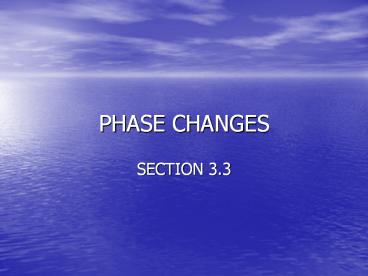PHASE CHANGES - PowerPoint PPT Presentation
Title:
PHASE CHANGES
Description:
PHASE CHANGES SECTION 3.3 CHARACTERISTICS OF PHASE CHANGES A phase change is the reversible physical change that occurs when a substance changes from one state of ... – PowerPoint PPT presentation
Number of Views:246
Avg rating:3.0/5.0
Title: PHASE CHANGES
1
PHASE CHANGES
- SECTION 3.3
2
CHARACTERISTICS OF PHASE CHANGES
- A phase change is the reversible physical change
that occurs when a substance changes from one
state of matter to another - Melting, freezing, vaporization, condensation,
sublimation, and deposition are six common phase
changes
3
- Temperature and Phase Changes
- The temperature of a substance does not change
during a phase change - When a solid changes to a liquid
- At first the temperature rises as a solid warms
up - At the melting point, the temperature stops
rising and remains the same until the melting is
complete - The temperature will begin to rise again
4
- 3. When a liquid changes to a solid
- a. At first the temperature of the liquid
- will drop until it reaches the freezing point
- b. At the freezing point, the temperature will
remain at that temperature until all of the
liquid freezes - c. After the freezing is complete, the
temperature will begin to drop again
5
- 4. The temperature at which a substance freezes
(its freezing point) is identical to the
temperature at which it melts (its melting point) - 5. When a liquid changes to a gas
- a. The temperature keeps rising until it
reaches the boiling point - b. The temperature then remains the same
until the boiling is complete
6
(No Transcript)
7
- Energy and Phase Change
- Energy is either absorbed or released during a
phase change - During an endothermic change, the system absorbs
energy from its surroundings - Melting, vaporization, and sublimation are all
examples of endothermic changes - The heat of fusion is the amount of energy a
substance must absorb in order to change from a
solid to a liquid. Fusion is another term for
melting
8
(No Transcript)
9
- 3. One gram of water releases 334 joules of
energy to its surroundings as it freezes. - a. This is the same amount of energy absorbed
when one gram of ice melts - b. Farmers use this release of energy to
protect their crops
10
- 4. During an exothermic change, the system
releases energy to its surroundings. Freezing,
deposition, and condensation are examples of
exothermic reactions
11
(No Transcript)
12
MELTING AND FREEZING
- The arrangement of molecules in water becomes
less orderly as water melts and more orderly as
water freezes - Melting
- In ice, the attractions between water molecules
keep the molecules in fixed positions - When ice is removed form the freezer, heat flows
from the air to the ice
13
- 3. As the ice gains energy, the molecules
vibrate more quickly. - 4. At the melting point of water some
molecules gain enough energy and move from
their fixed position. - 5. When all of the molecules gain energy
melting is complete.
14
- Freezing
- 1. When liquid water is placed in a freezer,
energy flows from the water to the air in the
freezer - 2. This process is the reverse of the melting
process.
15
VAPORIZATION CONDENSATION
- Vaporization is the phase change in which a
substance changes from a liquid into a gas. - A substance must absorb energy in order to change
from a liquid to a gas. - The heat of vaporization for water is equal to
2261 joules of energy.
16
- There are two vaporization processes boiling
and evaporation. - Evaporation takes place at the surface of a
liquid. - Evaporation is the process that changes a
substance form a liquid to a gas at temperatures
below the boiling point. - A vapor is the gaseous phase of a substance
- 3. Vapor pressure is the pressure caused by the
collisions of vapor and the walls of the
container.
17
(No Transcript)
18
- Boiling
- 1. When vapor pressure becomes equal to
atmospheric pressure, water boils. - 2. The temperature at which this happens is the
boiling point of water. - 3. As temperature increases, water molecules
move faster and faster.
19
- 4. When the temperature reaches 100C, some
molecules below the surface have enough kinetic
energy to overcome the attraction of neighboring
molecules. - 5. Because water vapor is less dense than
water, the bubbles rise to the surface.
20
- 6. The boiling point of a substance depends on
the atmospheric pressure. - a. At higher elevations the atmospheric
pressure is lower - b. This will cause the boiling point to occur
at a lower temperature. - c. Cooking will take longer at higher
elevations
21
- G. Condensation is the phase change in which a
substance changes from a gas or vapor to a
liquid. This process is responsible for the dew
on grass and the condensation on bathroom
mirrors.
22
SUBLIMATION DEPOSITION
- Sublimation is the phase change in which a
substance changes from a solid to a gas or vapor
without changing to a liquid first. - Example, at room temperature, dry ice can
directly change from a solid to a colorless gas.
23
- As dry ice sublimes, the cold carbon dioxide
vapor causes water vapor in the air to condense
and form clouds. - D. Deposition is the phase change that occurs
when a gas or vapor changes directly into a solid
without first changing to a liquid. - E. Deposition causes frost to form on windows































